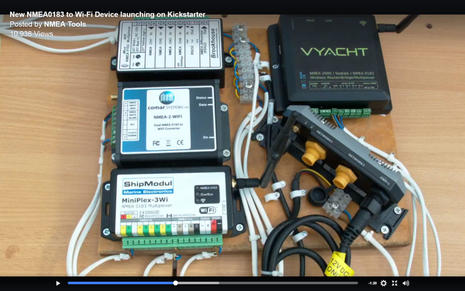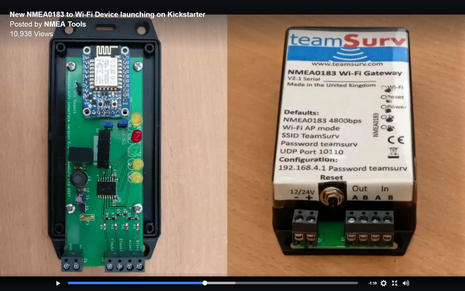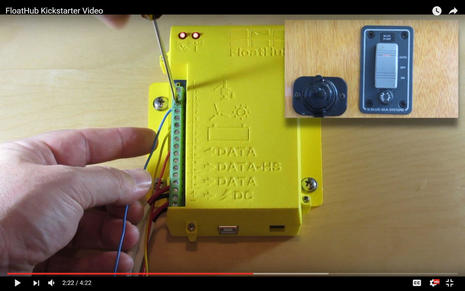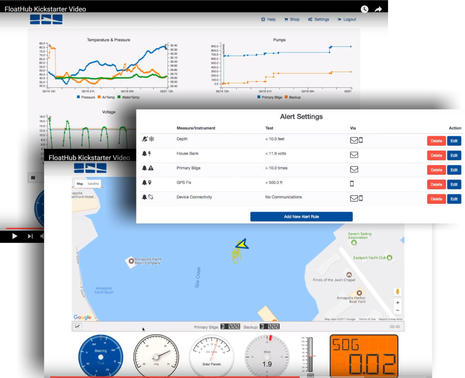NMEA to WiFi gateways: TeamSurv’s & FloatHub
 When it rains, it pours (particularly at Panbo HQ this “spring”). NMEA-to-WiFi bridges are quite useful — mainly for getting basic boat data like depth, GPS, and wind into the wonderful world of marine mobile apps — and there have been numerous choices for a while. But yesterday TeamSurv started offering an interesting and notably inexpensive new bridge on KickStarter, and the intriguing FloatHub bridge and monitoring system will join it there soon…
When it rains, it pours (particularly at Panbo HQ this “spring”). NMEA-to-WiFi bridges are quite useful — mainly for getting basic boat data like depth, GPS, and wind into the wonderful world of marine mobile apps — and there have been numerous choices for a while. But yesterday TeamSurv started offering an interesting and notably inexpensive new bridge on KickStarter, and the intriguing FloatHub bridge and monitoring system will join it there soon…
 Since 2010 TeamSurv has been involved in crowdsourcing depth survey data, and thus they’ve developed numerous tools for logging NMEA data. They also surveyed the field of NMEA-to-WiFi bridges, as shown on their NMEAtools.com/comparison page, and decided they could do better. Hence, the TeamSurv KickStarter campaign to presell a first batch of bridges for planned delivery in October.
Since 2010 TeamSurv has been involved in crowdsourcing depth survey data, and thus they’ve developed numerous tools for logging NMEA data. They also surveyed the field of NMEA-to-WiFi bridges, as shown on their NMEAtools.com/comparison page, and decided they could do better. Hence, the TeamSurv KickStarter campaign to presell a first batch of bridges for planned delivery in October.
Of course, TeamSurv is hoping to make it easier for more boaters to collect depth data — and, personally, I’d like to share my surveying with TeamSurv because they seem most committed to sharing it further (see co-founder Tim Thornton’s comments here) — but the bridge will be able to supply all sorts of data to all sorts of apps.
 According to the NMEAtools comparison page, TeamSurv’s is a basic NMEA-0183-only bridge with some excellent features like opto-isolation, configuration via web browser, and the ability to be a WiFi client instead of an access point. I always appreciate it when a company is willing to compare its product features with the competition, but I also look at such comparisons with a skeptical eye. In this case I don’t notice any obviously missing feature categories, but there certainly are other ways to accomplish the same goal.
According to the NMEAtools comparison page, TeamSurv’s is a basic NMEA-0183-only bridge with some excellent features like opto-isolation, configuration via web browser, and the ability to be a WiFi client instead of an access point. I always appreciate it when a company is willing to compare its product features with the competition, but I also look at such comparisons with a skeptical eye. In this case I don’t notice any obviously missing feature categories, but there certainly are other ways to accomplish the same goal.
For instance, the Digital Yacht iKommunicate gateway can deliver the same data to the same apps as well as support Signal K apps like the amazing WilhelmSK using a usually data richer NMEA 2000 network as the source. A Vesper XB8000 AIS transponder can also deliver boat data to mobile apps, sourced from either NMEA 0183 or 2000, and I will be detailing how fabulously Vesper has improved that feature set with what they call the smartAIS update. Their WatchMate app now delivers the best AIS and anchor drag alarming I know of, and it’s interactive with the XB8000 hardware alarm so the app doesn’t need to be open all the time. Brilliant.
 TeamSurv also had no way to know that FloatHub was coming along. In fact, you’re hearing it here first, and the FloatHub KickStarter campaign may not kick off for several months. But you, too, may be impressed with how much is already detailed in their YouTube video and in their Help section. For FloatHub, serving NMEA 0183 data over WiFi to mobile apps is a useful sideline, while full fletched 24/7 remote monitoring is the primary goal.
TeamSurv also had no way to know that FloatHub was coming along. In fact, you’re hearing it here first, and the FloatHub KickStarter campaign may not kick off for several months. But you, too, may be impressed with how much is already detailed in their YouTube video and in their Help section. For FloatHub, serving NMEA 0183 data over WiFi to mobile apps is a useful sideline, while full fletched 24/7 remote monitoring is the primary goal.
The planned FloatHub KickStarter price of $149 is not the bridge bargain TeamSurv seems to be offering, but it could be a great deal for remote monitoring with low subscription costs (and a $239 cellular model in alpha development). Also, I received a beta FloatHub WiFi hardware sample yesterday and will report on it in comments below.














Impressive. It was very easy to power up the FloatHub via USB, sign into its web app and tell it how to join my home WiFi network. Then, bada-boom, my location showed up on my secure FH cloud site (like on the last screen above) including air temp and pressure (sensor built in).
And the yellow box is also delivering GPS to iNavX running on my iPad. I’ve already seen what are likely beta glitches — like the inability to automatically sign back onto my WiFi after being depowered — but it looks like it will be easy to install FloatHub on Gizmo and add more inputs.
Thor here from the FloatHub team.
Ben, thanks for the feedback, much appreciated. On the failure to sign back into your local WiFi, it’s probably intended behavior, but something we need to better document. When the FloatHub device power cycles, it waits six or seven minutes before trying to rejoin any external WiFi. This is intentional, as it provides time for you to connect to the device’s local WiFi and change any settings. Otherwise, if the device is thrashing around trying to find an external signal (that may no longer exist if you’ve changed locations), that could prevent you from ever being able to update it.
We’ll add a FAQ for this in our support section as it can be confusing.
Ahem…someone ought to read the freakin manual. My beta FloatHub web site has a nice countdown timer showing the last data contact from the boat. It’s normally gray, but will apparently go to blue if there’s been no contact for an hour, and then red. Plus I can easily setup an email or text alert if connectivity fails over a period of xx minutes, hours, or days, an alert that won’t be triggered again over another period of xx minutes, hours, or days.
It’s the kind of the detail you really want to see in a monitoring system. Also, by design the FloatHub does not rejoin a WiFi network after a power reset because the rejoining process could interfere with someone using the device’s local WiFi to change settings, which is a fairly likely power reset situation.
But I will be quiet about FloatHub now because it is beta and may not be available for a fair while.
I’d recommend adding a small LCD and 4 buttons. Solves the which wifi should be used problem above. COGS probably less than $15. Or, just a single button that when you power on with button pressed, then it stays on local wifi mode. Waiting 6 minutes to join is a hack at best and a reason not to purchase at worst.
Thanks for the write up. Just to put a bit more context around our device in comparison to others on the market, what we found was plenty of devices that had Wi-Fi output as an add-on to their main functionality, e.g. a multiplexer, router or NMEA0183/N2K converter. But there wasn’t a simple NMEA0183 to Wi-Fi device at a sensible price, and our target has been to fill that gap. Also, to provide a fuller and more flexible implementation on the Wi-Fi and TCP/UDP side, as many products are deficient in this area. If people want a multiplexer I’d point them to ShipModul, or VYacht for a router, for example – we aren’t trying to compete with them.
Ben,
Sorry- I hadn’t registered- I have a Hunter 42 sailboat and have been looking for a way of connecting a wifi camera to my Raymarine e7D- without going to the expense of a Ray or Flir camera-my primary problem is with my genoa set I end up with a huge blind spot while under way to my lee side. I want to mount a camera under my pulpit seat on the bow and be able to turn it on and off quickly from my Ray screen- this sounds like it might be perfect- your thoughts? Of course the other application would be other cameras up the mast for coming into a suspect anchorage and in the engine room.
Eianm- Sydney, Australia
Eian, a NMEA 0183 or 2000 to WiFi gateway can’t help you with that. Neither data protocol has the bandwidth for video, or radar or sonar.
There’s only one marine nav display that can integrate directly with WiFi cameras and that’s certain current Garmin models with their own VIRB cams. You could get similar streaming and camera control with a VIRB and their phone or tablet app.
https://panbo.com/archives/2016/08/garmin_wireless_wonders_1_virb_xe_and_now_the_virb_ultra_30.html
The VIRB XE is particularly good as boat camera because there’s a waterproof 12v power supply cable available (and same for the new 360).
I hope that Navico, Raymarine, etc are considering similar boat integration with GoPro or similar wireless cams, but don’t know if any are.
thanks Ben, but i was talking to the Ray guys at the SCIBS boat show down here in Australia the week before last and they said if i connect an IP wifi camera to a wifi router and then connect that router by cable to my network socket i can control my camera on my e7D- haven’t yet tried it, but saw your article on the “NMEA to WiFi gateways: TeamSurv’s & FloatHub” and thought that is an even better potential option- couldn’t i connect one of these via the network cable on my Ray?
Why has no one tried using a bluetooth or wifi OBDII reader? They read CANBUS and are like 15 bucks…
Hi,
Bluetooth is possible, though it needs testing and licencing which is not required by Wi-Fi, so costs a fair bit more to develop.
OBDII devices could well work with N2K, but they will output N2K and almost all apps use NMEA0183 because of the costs of N2K licencing from NMEA – there are some open source reverse engineered implementations of N2K parsers around, though, so as these improve we may see more apps using N2K appearing, especially if they want to do more than the normal navigation applications.
Hi Ben,
the smallest N2K to WiFi gateway, with power consumption below 50 mA, just released: http://www.yachtd.com/products/wifi_gateway.html
With NMEA 0183 support, flexible filters (at N2K level, at 0183 level), 3 TCP/UDP servers with individual filters. We’ll send you it for test 😉
Not certified yet, at this moment our Engine Gateway is in progress (I hope that certification will be finished on this week), the next for ceritication will be USB Gateway. This product will be submitted for certification at the end of summer.
WBR,
Aleksandr,
Yacht Devices Ltd.
http://www.yachtd.com
Ben, can you comment on suitable sensors to use with these wifi products? My concern is that for example in a raymarine i70s system a wind offset will be stored in the instrument display. So the uncorrected data will be getting broadcast. I think a dst800 will be fine with an install that can calibrate it but I can’t find any information about wind!
Tough subject, Roblpm! Generally speaking, NMEA 2000 sensors that are calibrated with same brand tools output calibrated data. That’s obviously the ideal, but displays that can add calibrations just for their own display (or family of displays) sure are handy if you can’t calibrate the sensor itself.
I have not kept track of all the nuances, but certainly all Maretron sensors output data calibrated with their displays or software tool. I recall that Furuno and Navico often support local calibration but that doesn’t mean they can’t also write calibration to copectic sensors. And I thought that Raymarine was doing the latter with their own analog-to-N2K sensor gateways, discussed a bit here:
https://panbo.com/archives/2016/07/good_instrument_news_garmin_gwind_wireless_2_and_raymarine_i70s.html
As for NMEA 0183, most of the sensors are analog and the 0183 data going to the WiFi gateway is coming from the display, calibrated presumably.
There may also be marine instrument apps that offer local calibration like offsets, though I can’t name one.
I could be mistaken, but I think the TeamSurv product, despite being very attractive, has faded into oblivion. I can find one for sale used on eBay, the product web site seems to be kaput, and there are no vendors selling it.